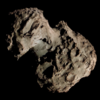 Hind's Comet visible in broad daylight on 30 March 1847 | |
| Discovery [1] | |
|---|---|
| Discovered by | John Russell Hind |
| Discovery site | London, England |
| Discovery date | 6 February 1847 |
| Designations | |
| 1847 I [2] | |
| Orbital characteristics [3] | |
| Epoch | 9 April 1847 (JD 2395760.5) |
| Observation arc | 77 days |
| Number of observations | 160 |
| Aphelion | ~945 AU |
| Perihelion | 0.043 AU |
| Semi-major axis | ~475 AU |
| Eccentricity | 0.99991 |
| Orbital period | ~10,300 years |
| Inclination | 48.664° |
| 23.824° | |
| Argument of periapsis | 254.36° |
| Mean anomaly | 0.0009° |
| Last perihelion | 30 March 1847 |
| TJupiter | 0.180 |
| Physical characteristics [4] | |
| Comet total magnitude (M1) | 6.8 |
| 4.3 (1847 apparition) | |
Hind's Comet, formally designated as C/1847 C1, is a non-periodic comet that became visible to the naked eye in March 1847. It is the second comet discovered by English astronomer, John Russell Hind.

